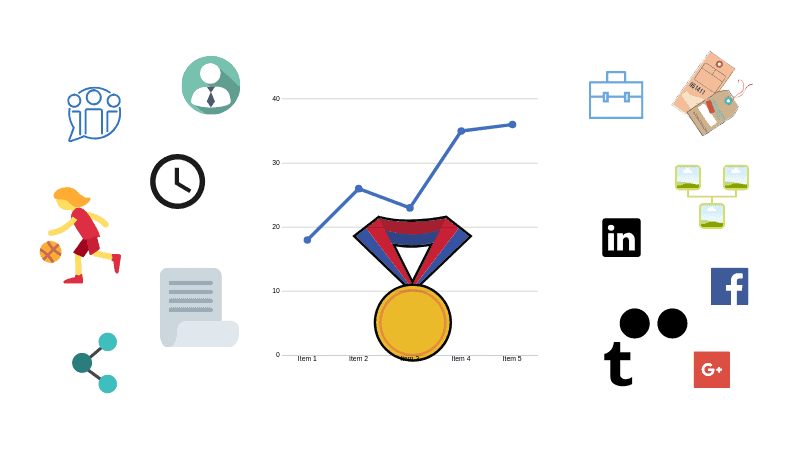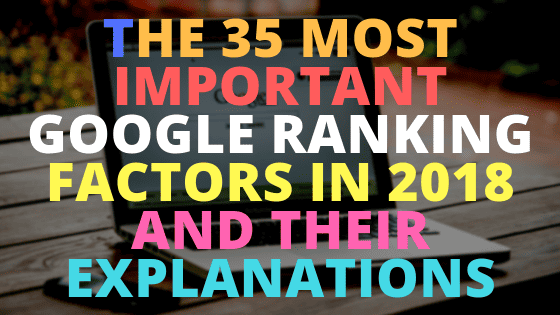What are the most important Google ranking factors?
The best thing to learn when creating content for your blog is to know how this content can be shown in Google. Aside from doing your SEO strategies, it is also important to discover some ranking factors that will help your website appear in search engines.
Some of the most important ranking factors that will have a great effect.

Load Speed – The speed of your website matters. Make sure to have a regular speed checks and optimisation of your site. You can check for website speed checkers in the internet, and one of those is Pingdom.
Security – It is very important to make sure the proper protection and encryption of the sites. Google assures that their users are far from danger. It also wants them to stay away from websites that could harm the reputation. With the proper security, website can rank higher in Google.
Sitemap – It helps both users and search engines to navigate the site and rank all the pages on your site.
Mobile Friendly – Almost half of the world wide web traffic is from mobile phones. Your website must be optimised for mobile devices and popular gadgets to be able for users to get easily access on the websites. Google is absolutely use this as a ranking factor.
Mobile Load Speed– This ranking factor is definitely an important factor to focus on as users of mobile phones are very active in terms of using internet. Image and video sizes must optimised properly to speed up the load performance. You can check your site’s mobile speed for free with testmysite.withgoogle.com. This tool offers speed testing, compares your website to top competitors and lets you know what to improve.
AMP- This is also referred to as Accelerated Mobile Pages. This affect on mobile rank and may not on desktop. Once AMP is installed, the device will receive a lightning bolt symbol on results page. Your web pages will automatically load.
Domain Age– The older the domain, the better it ranks in Google's results page.
Domain Authority- This is the same as domain age, the greater the authority of the site, the higher it ranks. For over 40 signals of Doman Authority almost all of them are influenced by external links. You can check your Domain Authority with the Website Authority Checker, and you can improve it by obtaining links from other high ranking sites.
Page Meta Descriptions – A meta description is the text that shows below the search result title. Each page and post needs one meta description to describe its content. It gives search engine a unique text to scroll and these descriptions include keywords for your target audience to look for.
Schema- is a list of microdata tags that is included in your website. It helps so Google to understand its contents faster and easier. You can go to schema.org to find out exactly how it works for your website.
Crosslinks- these are also known as internal links. Crosslinks are links within your website that connect pages and posts. Google uses internal links to examine the navigational quality of the website. To rank well on Google, make sure you use a lot of crosslinks to show its importance on Google.
Regularity/recentness- It is important that your website is regularly updated with fresh content. This is to keep your rankings stable and intact.
Quality Signals- This is one of the ranking factors that Google is looking at. These includes spelling and grammar errors.
Keyword density- Content must include keywords and packing it with too much amount of keywords is not allowed by Google. Nowadays web owners and SEO marketers are doing such a desperate act to rank. This attempt will lead to not quality content and is being monitored by Google.
Headline- user's search intent including headlines and page titles is more likely to rank than those without. Think of the possible keywords that most searchers are using then put those in your content.
Sub-headings- H2 and H3 tags are most commonly used in every page. Make sure that they are used properly relevant to H1. Sub headings help improve the navigational activities of the page. They also help your website rank in Google.
Table of Contents- a table of contents help the internal pages of the website to effectively navigate within the different pages. This shows Google how easy it is to jump into every link of the page.
Content Length- the number of words in your content has a contribution on its Google ranking. The more content on a webpage, the better ranking it takes. Based on studies from Backlinko, the average words the page must contains must be more than a thousand content words.
Keyword position in Headlines- Headline is one of the most important part of the content to place keywords. Having one or two of your main keywords in the headline helps it rank higher.
Slug or URL extension– this is also represent as the title of the page being seen in the domain of the website. It is known as the slug and is separated with a hyphen. Make it short so it will be user friendly.
Subdomain– aside from slugs or URL extension, other websites choose to use subdomains. These are relevant to sites that are producing content which aren't directly relevant to their domain.
Content Meta Description- every content that is being published must have a meta description, that include the keyword you’d like to rank for in order to show in search engines. Google regularly change its algorithm and part of it is the character limits of the meta description. Make sure to update it regularly.
Variety of Content– one of the most increasing ranking factor is having a use of video in the content. It is also an aspect of marketing to have it shared in social media platforms. Engaging people in social shares with the mix of audio, images and video attract more people helps the website rank in search engines.
Alt Text Tags- Alt tags appear as an anchor for an image. To keep the ranking higher, make sure to include your keywords in alt tags with an uploaded image on your site.
Solid Links– Google don't consider outbound links as a ranking factor. However, they penalise your website if you link to untrustworthy sites. Make sure to stay away from broken or dead links. You can check the links with the a free tool BrokenLinkCheck to stay on top of the competition.
Bullet Points and Numbered Lists- It is easy and clear to read having a page with bullets and numbered lists content. Users can understand better the context of the page using these and Google will also find it easy to indexed.
Bounce rate- The number of visits that easily gets away from your website after viewing it for once, affect Google's ranking factor. Make sure that you have enough content your visitors are looking for to avoid them from bouncing.
Time on site- Google monitors the time of a user spend in viewing the site.. The longer the time visit, the greater the indication that the site has quality content. User doesn't stay longer than a minute if he is not interested on what he is reading. Video and images in the content has a lot more chance of getting these numbers.
Pages per session- This signifies the number of pages a visitor views before leaving a website. More number which combined with time on site indicates great content quality.
Direct website visits- It is consider a strong ranking factor having a driect website visits. This means that a visitor has a loyal visit who come directly to your site. It is a proof that w website has high quality content.
Social signals- social media alone has nothing to do with the page rank. However, shres, likes, comments and followers can do a lot when it comes on website ranking.
Business listing (inc. contact)- your business information means a lot to Google. Listing the contact information, opening hours and location can help users to easily find your business, as well as Google for building trust and shows transparency.
Backlinks- linking your site or page to a relevant content from an external site is what a backlink's role. It is consider to be an important factor in Google because of its performance, domain authority and referral traffic.
Domain Authority of Backlinks- be careful in putting backlinks to your page. Not all relevant content can be your backlinks. Check if the Domain Authority is high, then you can put them as your backlink. Low relevant backlinks effect nothing in your rankings in search engines.
Click-through-rate (CTR)- your content when shown in Google attracts viewers when they saw quality and related content to target terms. People tend to click on your webpage and stay there as long as they want. Clicks indicate your website's attraction to its users and that is called impression. The higher the number of clicks to the site, the higher you rank in Google.

